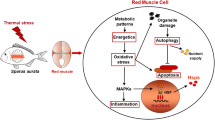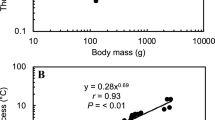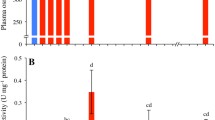Abstract
The adaptability/plasticity of the highly oxidative red muscle in Atlantic salmon was demonstrated during spawning migration. Substrate concentrations and the enzymatic pathways of ATP production were examined in red muscle obtained from Atlantic salmon at different sites along their migratory route in the Exploits River, Newfoundland, Canada. Individuals were chronologically sampled from a seawater site, two sites upstream, and at spawning. The 20% decrease in salmon body weight during the later stages of migration was accompanied by large decreases (mg dry weight−1) in both glycogen (P < 0.01) and total muscle lipid (P < 0.01). In contrast, water content and protein concentration (mg dry weight−1) of the red muscle increased by 25 and 34%, respectively, at spawning. Enzymes of the glycolytic pathways demonstrated a significant (P < 0.001) decrease in maximal activity as migration proceeded whereas enzymes of the oxidative phosphorylation pathways, specifically the citric acid cycle enzymes, exhibited an increase (P < 0.001) in maximal activity at spawning. The antioxidant enzyme superoxide dismutase also demonstrated an increase (P < 0.001) in maximal activity during the latter stages of migration. These adaptations imply that the red epaxial muscle of Atlantic salmon has a more efficient means of oxidizing lipids, while minimizing free radical damage, during the later stages of migration and spawning, thereby potentially increasing post spawning survival.





Similar content being viewed by others
References
Aebi H (1984) Catalase in vitro. Methods Enzymol 105:121–126. doi:10.1016/S0076-6879(84)05016-3
Bligh EG, Dyer WJ (1959) A rapid method of lipid extraction and purification. Can J Biochem Physiol 37:911–917
Butler DG (1969) Hormonal control of gluconeogenesis in the North American eel (Anguilla rostrata). Gen Comp Endocrinol 10:85–91. doi:10.1016/0016-6480(68)90012-9
Chi MM, Hintz CS, Coyle EF, Martin WH 3rd, Ivy JL, Nemeth PM, Holloszy JO, Lowry OH (1983) Effects of detraining on enzymes of energy metabolism in individual human muscle fibers. Am J Physiol 244(13):C276–C287
Drodge W (2002) Free radicals in the physiological control of cell function. Physiol Rev 82:47–95
Duscha BD, Kraus WE, Keteyian SJ, Sullivan MJ, Green HJ, Schachat FH, Pippen AM, Brawner CA, Blank JM, Annex BH (1999) Capillary density of skeletal muscle A contributing mechanism for exercise intolerance in Class II-III chronic heart failure independent of other peripheral alterations. J Am Coll Cardiol 33:1956–1963. doi:10.1016/S0735-1097(99)00101-1
Flohe L, Becker R, Brigelius R, Lengfelder E, Otting F (1989) Convenient assays for superoxide dismutase. In: Miquel J, Quintanilha A, Weber H (eds) Handbook of free radicals and antioxidants in biomedicine, vol III. CRC, Boca Raton, FL, pp 287–293
Geist RD, Abernethy CS, Blanton SL (2000) The use of electromyogram telemetry to estimate energy expenditure of adult fall Chinook salmon. Trans Am Fish Soc 129:126–135. doi:10.1577/1548-8659(2000)129<0126:TUOETT>2.0.CO;2
Gollnick PD, Saltin B (1982) Significance of skeletal muscle oxidative enzyme enhancement with endurance training. Clin Physiol 2:1–12. doi:10.1111/j.1475-097X.1982.tb00001.x
Green H, Morrissey H, Smith D, Fraser I (1985) Relationships between microphotometric determinations of succinic dehydrogenase activity in single fibers using kinetics and end point criteria. Med Sci Sports Exerc 17(2):193. doi:10.1249/00005768-198504000-00056
Green H, Grant S, Bombardier E, Ranney D (1999) Initial aerobic power does not alter muscle metabolic adaptations to short-term training. Am J Physiol 277:E39–E48
Green HJ, Tupling R, Roy B, O’Toole D, Burnett M, Grant S (2000) Adaptations in skeletal muscle exercise metabolism to a sustained session of heavy intermittent exercise. Am J Physiol Endocrinol Metab 278:E118–E126
Green HJ, Bombardier EB, Duhamel TA, Holloway GP, Tupling AR, Ouyang J (2008) Acute responses in muscle mitochondrial and cytosolic enzyme activities during heavy intermittent exercise. J Appl Physiol 104:931–937. doi:10.1152/japplphysiol.01151.2007
Guderley H, Blier P, Richard L (1986) Metabolic changes during the reproductive migration of two sympatric coregonines, Coregonus artedii and Coregonus clupeaformis. Can J Fish Aquat Sci 43:1859–1865
Hazel JR, Prosser CL (1974) Molecular mechanisms of temperature compensation in poikilotherms. Physiol Rev 54:620–677
Hendry AP, Beall E (2004) Energy use in spawning Atlantic salmon. Ecol Freshwat Fish 13:185–196. doi:10.1111/j.1600-0633.2004.00045.x
Henriksson J, Chi MM-Y, Hintz CS, Young DA, Kaiser KK, Salmons S, Lowry OH (1986) Chronic stimulation of mammalian muscle: changes in enzymes of six metabolic pathways. Am J Physiol 251:C614–C632
Hood DA, Chabi B, Menzies K, O’Leary M, Walkinshow D (2007) Exercise-induced mitochondrial biogenesis in skeletal muscle. In: Stocchi V, DeFeo P, Hood DA (eds) Role of physical exercise in preventing disease and improving quality of life. Springer Milan, Toronto, pp 37–60
Idler DR, Bitners I (1958) Biochemical studies on sockeye salmon during spawning migration. II. Cholesterol, fat, protein, and water in the flesh of standard fish. Can J Biochem Physiol 36:793–798
Idler DR, Clemens WA (1959) The energy expenditures of Fraser River sockeye salmon during spawning migration to Chilko and Stuart Lakes. Int Pac Salmon Fish Comm Prog Rep 6:1–80
Ince BW, Thorpe A (1976) The effects of starvation and force-feeding on the metabolism of the northern pike, Esox lucius L. J Fish Biol 8:79–88. doi:10.1111/j.1095-8649.1976.tb03909.x
Jansenns BJ, Childress JJ, Baguet F, Rees JF (2000) Reduced enzymatic antioxidative defense in deep-sea fish. J Exp Biol 203:3717–3725
Jayne BC, Lauder GV (1994) How swimming fish use slow and fast muscle fibers: implications for models of vertebrate muscle recruitment. J Comp Physiol A 175:123–131. doi:10.1007/BF00217443
Johnston IA, Moon TW (1980) Exercise training in skeletal muscle of brook trout (Salvelinus fontinalis). J Exp Biol 87:177–194
Jones PL, Sidell BD (1982) Metabolic responses of striped bass (Morone saxatilis) to temperature acclimation. II. Alterations in metabolic carbon sources and distributions of fiber types in locomotory muscle. J Exp Zool 219:163–171. doi:10.1002/jez.1402190205
Jonsson B, Jonsson N (2003) Energy allocation among developmental stages, age groups, and types of Atlantic salmon (Salmo salar) spawners. Can J Fish Aquat Sci 60:506–615. doi:10.1139/f03-042
Jonsson N, Jonsson B, Hansen LP (1997) Changes in proximate composition and estimates of energetic costs during upstream migration and spawning in Atlantic salmon. J Anim Ecol 66:425–436. doi:10.2307/5987
Leonard JB, McCormick SD (1999) Effects of migration distance on whole-body and tissue-specific energy use in American shad (Alosa sapidissia). Can J Fish Aquat Sci 56:1159–1171. doi:10.1139/cjfas-56-7-1159
Lopez-LLuch G, Hunt N, Jones B, Zhu M, Jamieson H, Hilmer S, Cascajo MV, Allard J, Ingram DK, Navas P, de Cabo R (2006) Calorie restriction induces mitochondrial biogenesis efficiency. Proc Natl Acad Sci USA 103:1768–1773. doi:10.1073/pnas.0510452103
Love RM (1980) The chemistry of Fishes, vol 2. Academic Press, New York, pp. 70–109 and 166–226
Lyle AA, Elliott JM (1998) Migratory salmonids as vectors of carbon, nitrogen and phosphorus between marine and freshwater environments in north-east England. Sci Total Environ 210/211:457–468. doi:10.1016/S0048-9697(98)00031-X
Marklund S, Marklund G (1974) Involvement of the superoxide anion radical in the autoxidation of pyrogallol and a convenient assay for superoxide dismutase. Eur J Biochem 47:469–474. doi:10.1111/j.1432-1033.1974.tb03714.x
Martin NB, Houlihan DF, Talbot C, Palmer RM (1993) Protein metabolism during sexual maturation of female Atlantic salmon (Salmo salar L.). Fish Physiol Biochem 12:131–141. doi:10.1007/BF00004378
Mommsen TP, French CJ, Hochachka PW (1980) Sites and patterns of protein and amino acid utilization during the spawning migration of salmon. Can J Zool 58:1785–1799
Passonneau JV, Lowry OH (1993) Enzymatic analysis: a practical guide. Humana Press, New Jersey, pp 111–305
Patterson S, Johnston IA, Goldspink G (1974) The effects of starvation on the chemical composition of red and white muscles in the plaice (Pleuronectes platessa). Experientia 30:892–894. doi:10.1007/BF01938344
Polachek I, Cabib E (1981) A simple procedure for protein determination by the Lowry method in dilute solution and in the presence of interfering substances. Anal Biochem 117:311–314. doi:10.1016/0003-2697(81)90784-3
Rodnick KJ, Sidell BD (1994) Cold acclimation increases carnitine palmitoyltransferase I activity in oxidative muscle of striped bass. Am J Physiol 266(35):R405–R412
Wallimann T (1994) Bioenergetics: dissecting the role of creatine kinase. Curr Biol 4:42–46. doi:10.1016/S0960-9822(00)00008-7
Wood JD, Duncan DW, Jackson M (1960) Biochemical studies on sockeye salmon during spawning migration. XI. The free histidine content of the tissue. J Fish Res Board Can 17:347–351
Acknowledgments
This work was supported by a National Sciences and Engineering Research Council (NSERC) grant to RSM and HJG. The authors would also like to acknowledge the support and help of the Department of Fisheries and Oceans.
Author information
Authors and Affiliations
Corresponding author
Rights and permissions
About this article
Cite this article
Bombardier, E., Booth, R.K., Green, H.J. et al. Metabolic adaptations of oxidative muscle during spawning migration in the Atlantic salmon Salmo salar L.. Fish Physiol Biochem 36, 355–365 (2010). https://doi.org/10.1007/s10695-008-9300-8
Received:
Accepted:
Published:
Issue Date:
DOI: https://doi.org/10.1007/s10695-008-9300-8




